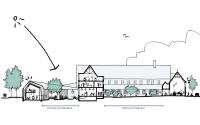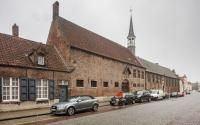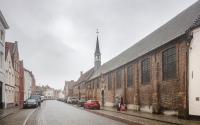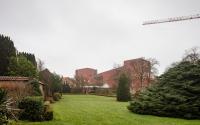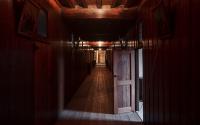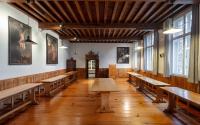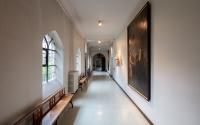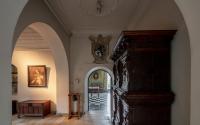Brugge - Abbey of St Godelieve

Award

B-architecten nv, B-juxta architecten
Download design proposalThe study and design assignment for the drawing up of a master plan for the overall restoration and redevelopment of the St Godelieve Abbey in Bruges and the execution of a first phase was awarded to the temporary partnership B-architecten and Juxta Architecture, with as subcontractors: Daidalos Peutz, Erfgoedstudio, Mar Jaen, Mouton, Omgeving Landscape.Urbanism, Studio Tuin en Wereld - a&t architecten, Sweco, TC Plus.
Within the protective walls of St Godelieve Abbey, moments of prayer and contemplation (ora) alternated with moments of work and effort (labora). Both labour and prayer were an essential part of monastic life. The design team starts from the ambition to respect and reinterpret these principles of ora et labora, so that the abbey not only continues to offer silence, peace and security, but also becomes a place where various activities and encounters can take place.
The designers define two pathways, ‘abbey’ and ‘lock’, which will organise the flow of visitors. The abbey lodge, workplaces, kitchen garden and other generous spaces will tell the story of quiet, private monastic life. The crafts, such as bakery and brewery, will become part of the abbey trail. They tell the story of the working community. The connection of the two worlds is central to the design team’s concept. The transition between the castle and the abbey, between ora and labora, is spatially shaped by the hortus connectens. While the hortus conclusus is the centre of the enclosed monastic life and expresses the sacred, the hortus connectens is defined as the centre of the abbey and as a connection to the profane.
A new pavilion will embrace the hortus connectens. The pavilion offers shelter and work can be done there. It introduces visitors to the productivity of the site and also allows them to enter the lock here. The lock will be complemented by a circulation core that makes it integrally accessible and more usable for the future. At the same time, it remains as untouched as possible. The same principle applies to the infill of the gardens. The layout will be grafted onto the historical structure as much as possible, incorporating water buffering, techniques and integral accessibility. The kitchen garden will be laid out in accordance with the historical structure and the orchard will be planted with fruit trees.
Amidst this, the hortus connectens the connection between abbey and castle, and between orchard and kitchen garden. It will be a place of interweaving where people are brought together and set in motion. In this way, St Godelieve Abbey will become not only a place of reflection, but also a living monument that can be put to full use. A place where traditions are respected, but where new traditions are also created.
Selection
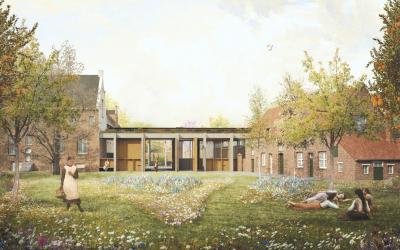
aNNo architecten, Atelier Arne Deruyter
Download design proposal
Architectenbureau Sabine Okkerse bvba, Compagnie O. , Plant en Houtgoed
Download design proposal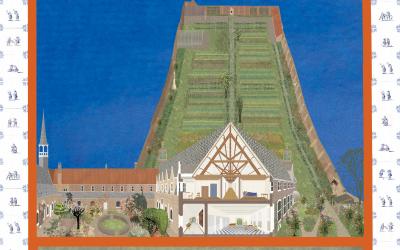
noAarchitecten
Download design proposalProject description
The Abbey of St Godelieve was founded here in 1586, when the Benedictines of Saint Godelieve of Gistel sought refuge within the city of Bruges. The Monastery of St Godelieve was built and expanded gradually. The complex occupies a large area between Boeveriestraat and Koning Albert I-laan, with spacious gardens. The monastery complex almost retained its historically evolved layout with the church and the nuns’ choir from 1626 on the east side of Boeveriestraat. In the continuation of this lies the entrance building of 1633 and, at right angles to the church, the south wing of 1643. A cloister runs around a square courtyard against the eastern façade of the church. Perpendicular to the entrance building lies the 1885 wing. In 1953 a wing – not listed as a monument – was added after a design by the Bruges architect A. Degeyter. It served as a connection between the 1643 and 1885 wings. This closes off the east side of the garden.
Like many centuries-old religious heritage, this building lost its original purpose with the departure of the last nuns in 2013. Tourism Flanders obtained the monastery site of 11,000 m² including the buildings and their furnishing on a long lease. Today, Tourism Flanders is considering a new approach to this heritage in a pilot project under the motto ‘Travelling to Tomorrow’. By involving the citizens of Bruges in a participatory research of wishes and possibilities, the expectations were mapped out in 2021. The question is how to deal with this heritage and what repurposings are possible in these buildings. It is a matter of dealing with this valuable site in its singularity of ‘ora et labora’ and at the same time of making it a living and used monument. In that preliminary process, various forms of use in parts of the site were also examined for their feasibility. This research will lead to a clear project definition in late February 2022, but probably not yet to concrete users, nor to a final programme of requirements. The value of the heritage will determine what is possible. The assignment is to preserve this heritage, to optimize it structurally in terms of energy consumption and techniques, to make it fire safe and easily accessible, and at the same time to make it suitable for all kinds of uses and purposes that may be hosted on site.
To this end, we are looking for a quality vision and a feasible approach. In the first instance, the investment budget is limited to 4 million euros. In order to guarantee an overall approach, a master plan is necessary. In this way the various phases and investments can contribute to a valuable end result. Thus, the design team will first prepare a master plan for the comprehensive approach and an implementation file for a meaningful use of resources in a first phase. The master plan will initially be based on the intrinsic qualities and possibilities of the current building, leaving plenty of room for the changing specifics that fit in the hardware. Meanwhile, Tourism Flanders is looking for additional resources and/or private investors or concession holders. Depending on the result, a study assignment will follow conditionally for the overall restoration or a supervision assignment for the quality monitoring of the master plan.
The project is initiated by Tourism Flanders but will be implemented in collaboration with private partners.
It should be possible to establish the deployment of funds for a first phase by late 2022. Therefore, the commissioning authority wants to adhere to the following strict timing:
- selection: March 2022
- first briefing: April 2022
- submission of tenders: June 2022
- award: July 2022
- completion of master plan and implementation file first phase tender-ready: November 2022
- Tender first phase: early 2023
To be submitted with the application
- The ESPD must be included among the documents in ‘My Open Call’ (the online profile on the website).
- Non-Belgian applicants must also attach their supporting documents regarding tax and social debts and a non-bankruptcy certificate through their ‘My Open Call’ account.
- A motivation text and 3 reference projects explaining their relevance must be added to the online application module.
- The portfolio (.pdf) with max. 20 pages in A4 size(*) (**) will be added in the online application process and will contain the following information:
- cover (1 A4)
- certificate of registration with the order of architects (1 A4)
- the CVs of 3 members of the project team who are guaranteed to work on this assignment, demonstrating the requested expertise (max. 2 A4s per team member)
- clarification regarding the 3 reference projects (max. 4 A4s per project) - If an applicant relies on third-party capacity, the portfolio should be expanded to include:
- the signed commitment agreement of the office relied upon
- the ESPD of the office relied upon
* Portfolios exceeding 20 pages will be shortened to the first 20 pages. Anything from page 21 onwards will not be considered in the further selection process.
** If the applicant relies on the capacity of a subcontractor, only the subcontractor’s signed commitment agreement and ESPD will be considered in addition to the first 20 pages.
Selection conditions
An application must meet the following conditions to be considered for selection:
- Applicants must be registered with the Order of Architects.
- A motivation text must be submitted regarding the social dimension of the assignment. In doing so, the candidate demonstrates that his or her work method can achieve a social objective and guarantee the public function.
- A project team will be formed consisting of 3 people who are guaranteed to work on the assignment. In terms of expertise, the project team should be composed as follows:
- 1 architecture expert
- 1 restoration expert
- 1 garden and landscape architecture expert.
- the project manager can demonstrate 5 years of experience. - The applicant must submit 3 of their own reference projects. The reference projects must meet the following conditions:
- 1 realization of a restoration with a minimum construction budget of 4 million euros
- 1 realization or design of a repurposing project
- 1 realization or design of a garden or landscape within a heritage project.
- The references must explain the role the designer played in the submitted project.
Reliance on third-party capacities
If an office or temporary association does not meet the requirements, it may rely on the capacity of third parties:
- if it cannot provide the requested references
- if it cannot present the necessary expertise within the 3-person project team.
Between offices within the same temporary association, the capacity of another office within the temporary association need not be relied upon.
Selection and award criteria
Please read the selection guideline. There you can find:
- the grounds for exclusion
- the selection criteria (suitability and technical and professional competence)
- the award criteria
- the description of the evidence and documents to be submitted
- the framework conditions and content of the portfolio
Project details
Project code
OO4302
Official name
All-inclusive study assignment to draw up a master plan for the comprehensive restoration and repurposing of the Abbey of St Godelieve in Bruges (including monitoring quality control) and the execution of a first phase. The execution of subsequent phases forms a conditional part of the assignment.
This project is part of the project bundle OO43.
Status
Being built
Client
Toerisme Vlaanderen
Site location
Boeveriestraat 45
8000 Brugge
Belgium
Timing project
- Selection meeting:
- Deadline offers:
- Jury:
Contactperson client
Kristof Lataire
Contact Team Vlaams Bouwmeester
Anne Malliet
Award procedure
Competitive procedure with negotiation
Financial
Construction budget
Including VAT
Including commission
Commission
Fee for offers
Project type
Function
European publication
- Date European publication:
- Number European publication: 4301: 2022/S 015-034580 - 4302: 2022/S 015-034582 - 4303: 2022/S 015-034583
Publication bulletin
- Date publication bulletin:
- Number publication bulletin: 4301: 2022-501848 - 4302: 2022-501847 - 4303: 2022-501846
This project was realized via Open Oproep. Read more about this tool.
Last reviewed on: .




